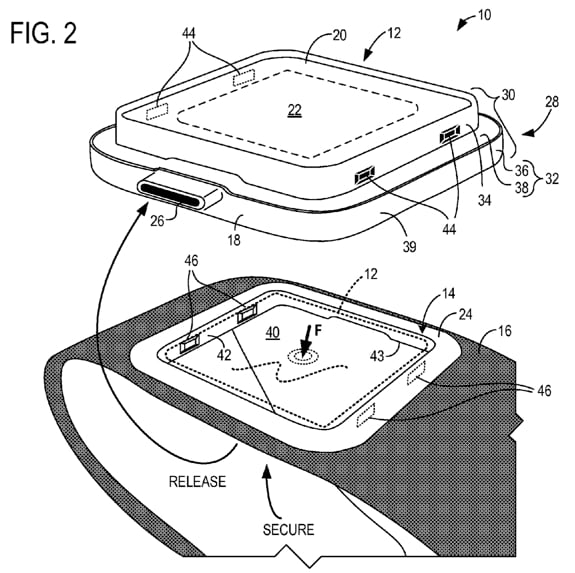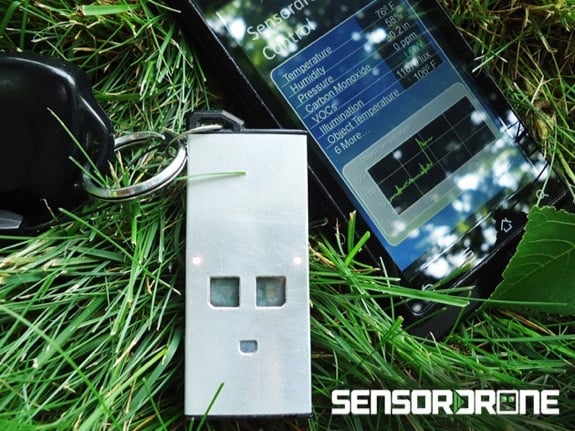Latest Gear Live Videos
Deal of the Day: 25% off the Sensordrone

Posted by Andru Edwards Categories: Accessories, Smartphones, Hot Deals, Wireless / WiFi,
Today in the Gear Live Deals Shop we're got an awesome 25% discount on the Sensordrone Bluetooth Sensor. Connect this thing to your smartphone over Bluetooth, and you've got a supercharged device that can monitor things like carbon monoxide levels, temperature, weather, gas leaks, and more. Other sensors include light, pressure, color, and proximity. It's good enough to be our Deal of the Day! There are almost a dozen apps you can download that can take advantage of the data that the Sensordrone provides, with more to come. Check out the video below that gives more details.
Don’t forget, if you’re looking for other deals, be sure to check out our Newegg Promo Code thread. Oh, and if you're on Twitter, be sure to follow @TechPromos for the latest deals.
Click to continue reading Deal of the Day: 25% off the Sensordrone
Advertisement
Microsoft files its own smart watch patent

Posted by Ariel Levin-Waldman Categories: Wearables, Corporate News, Microsoft,

With the smartphone being a huge success, companies like Samsung and Sony got the idea to make it smaller and wrist mounted, creating the Galaxy Gear and Sony Smartwatch lines respectively. Now Microsoft has decided to muscle into the game, registering its patents with the U.S. Government this week.
The application filed with the patent office describes the wearable as a music player, phone, message device, and fitness measuring device. The watchface would be detachable from the wristband so that it can be connected to a charging port.
The features described are still speculation, and no date has been stated for release. Microsoft is up against competition from Samsung, who released their product last year, Motorola, which plans to release the Moto 360 in July, and Pebble, which has already sold over 400,000 units.
XDriven Driving Surveillance Recorder

Posted by Sheila Franklin Categories: Cameras, GPS, Transportation,
 The Automated Driving Surveillance Recorder works whether the driver is parked or moving and has sensors that detect speed, breaking and acceleration. When an accident occurs, it will take images of both before and after the event. Also included is a GPS logger that records date, time and location. Choose between Accident/Event or manual settings for the device that includes software for later playback of recorder footage. The DVR comes with a mount, 1GB SD card, and power cable and is available for $399.99.
The Automated Driving Surveillance Recorder works whether the driver is parked or moving and has sensors that detect speed, breaking and acceleration. When an accident occurs, it will take images of both before and after the event. Also included is a GPS logger that records date, time and location. Choose between Accident/Event or manual settings for the device that includes software for later playback of recorder footage. The DVR comes with a mount, 1GB SD card, and power cable and is available for $399.99.
Read More  | Advanced Camera Tech
| Advanced Camera Tech
Kickbee Allows Unborn Baby to Twitter

Posted by Sheila Franklin Categories: Wearables, Internet, Misc. Tech,
 Corey Menscher, a technologist, interaction designer and web application developer, wanted to know what his unborn baby was up to as his pregnant wife did. He created the Kickbee, a stretchy band embedded with sensors that react to movement with an Arduino microcontroller. He then decided to transmit them by Bluetooth to a MacBook Pro and from there sends Twitter updates. Our first reaction was to wonder if the baby would be affected by the procedure. This is what Corey had to say.
Corey Menscher, a technologist, interaction designer and web application developer, wanted to know what his unborn baby was up to as his pregnant wife did. He created the Kickbee, a stretchy band embedded with sensors that react to movement with an Arduino microcontroller. He then decided to transmit them by Bluetooth to a MacBook Pro and from there sends Twitter updates. Our first reaction was to wonder if the baby would be affected by the procedure. This is what Corey had to say.
“I’d also like to respond to some comments about “irradiating” my baby. The piezo sensors are simple sensors that generate a very small electrical current when tapped or vibrated. They are not powered in any way…I’ve spoken to faculty about this, and considering the very low wattage, it’s unlikely much of the electromagnetic radiation will reach the baby. Even so, I’m looking into placing the circuitry on radio-absorbing material.”
By the way, we checked out the Kickbee Twitter page and noticed that it simply states when the fetus kicks.
Oh, and as an aside, if you are on Twitter, feel free to follow us: @gearlive.
Read More  | Kickbee
| Kickbee
Midori-san, The Blogging Plant

Posted by Sheila Franklin Categories: Internet, Misc. Tech, Science,

We once witnessed a plant’s reaction with a lie detector to someone’s bending one of its leaves and were pretty impressed that the plant exhibited stress. But Midori-san, a Sweetheart Hoya, makes that look juvenile in comparison. Satoshi Kuribayashi of KAYAK has developed sophisticated technology that allows the house plant to blog on line. With surface potential sensors, it measures changes such as temperature, vibration, and nearby humans. An algorithm translates that data into Japanese sentences that make up the blog. You can monitor Midor-san and offer it a dose of light through its site, which seems to lose something with the translation.
Read More  | Pink Tentacle
| Pink Tentacle
Oregon Weather Light Rocket Clock

Posted by Sheila Franklin Categories: Misc. Tech, Science,

Want to know what the weather will be like when you get up in the morning without listening to a real human? The Oregon Weather Light Clock has 3 illuminated icons to give you a reading of sunny, cloudy, and rainy. Wave your hand and you get both Atomic time and in and outdoor temperatures. Set it on auto-toggle display and it will do just that. With LED backlighting, the rocket clock can be set for 12 or 24 hour time with either Celsius or Fahrenheit measurement. It comes with outdoor sensor and is available for £49.99 (~$100.00.)
Streetline Informs Drivers of Available Parking

Posted by Sheila Franklin Categories: Misc. Tech, Transportation,
 Streetline has gotten together with San Francisco, which is apparently willing to spend $95 million so that 25% of the city can find a place to park. Drivers will be notified via smartphone and signs and will be able to pay via their phones as well eventually. The city is hoping to cut down on traffic congestion.
Streetline has gotten together with San Francisco, which is apparently willing to spend $95 million so that 25% of the city can find a place to park. Drivers will be notified via smartphone and signs and will be able to pay via their phones as well eventually. The city is hoping to cut down on traffic congestion.
Streetline claims that their service gives the status of curbside, lot and garage spaces 24 hours a day, every day. The system consists of a wireless sensor inside a 4 x 4-inch piece of plastic fastened to the pavement next to the space.
Read More  | Chip Chick
| Chip Chick
Monkeys Control Robotics With Brain Waves

Posted by Sheila Franklin Categories: Misc. Tech, Science,
 In order to assist those who are paralyzed, researchers have been training monkeys to feed themselves with the use of a robotic arm. The monkey uses its brain to control sensors and let the arm know that it wants a marshmallow. The team say that one monkey has already achieved a 78% success rate. Head of the U. of Pittsburgh team, Andrew Schwartz, says that it won’t be long before the technology will be tested on humans, but it may be a several years before making it to the mainstream.
In order to assist those who are paralyzed, researchers have been training monkeys to feed themselves with the use of a robotic arm. The monkey uses its brain to control sensors and let the arm know that it wants a marshmallow. The team say that one monkey has already achieved a 78% success rate. Head of the U. of Pittsburgh team, Andrew Schwartz, says that it won’t be long before the technology will be tested on humans, but it may be a several years before making it to the mainstream.
Read More  | CNN
| CNN
FATS Shoes for Fat Kids

Posted by Sheila Franklin Categories: Wearables, Design, Videos,
What better way to remind your child that she/he is on their way to obesity than to present them with a pair of FATS (Fitness Achievement Technology System) shoes. Created by students from the Utrecht School of Arts in the Netherlands, the more the kids work out, the more the color appears. This is accomplished by a motion sensor integrated into the shoe’s heel that, along with glass fiber yarn woven on the outside, reflects the light from LEDs. While we think that most kidlets we know would prefer being rewarded with a twinkie or more video game time for exercising, we suspect that this prototype may work on the same little ones that wear those blinking light shoes for safety reasons.
Read More  | FATS Shoe Project
| FATS Shoe Project
Military Uses Wii With Packbot

Posted by Sheila Franklin Categories: Misc. Tech, Science, Video Games,
 Who says the military is not into games? When we last told you about the iRobot Packbot, it had barely taken off as a prototype that could fly with a parafoil system. The USDE has been busy and is now teaching its battlefield model, which features a gun and sensory equipment, to run via a Wii controller. It seems that the soldiers spent more time operating the bot than in reading data and they figured this would be a more useful alternative. Engineers have developed software that will send back vibrations if it finds something of importance, like an injured soldier. They would also like to hook it up to an iPhone sometime in the future.
Who says the military is not into games? When we last told you about the iRobot Packbot, it had barely taken off as a prototype that could fly with a parafoil system. The USDE has been busy and is now teaching its battlefield model, which features a gun and sensory equipment, to run via a Wii controller. It seems that the soldiers spent more time operating the bot than in reading data and they figured this would be a more useful alternative. Engineers have developed software that will send back vibrations if it finds something of importance, like an injured soldier. They would also like to hook it up to an iPhone sometime in the future.
Read More  | New Scientist Tech
| New Scientist Tech
Advertisement
© Gear Live Inc. {year} – User-posted content, unless source is quoted, is licensed under a Creative Commons Public Domain License. Gear Live graphics, logos, designs, page headers, button icons, videos, articles, blogs, forums, scripts and other service names are the trademarks of Gear Live Inc.











